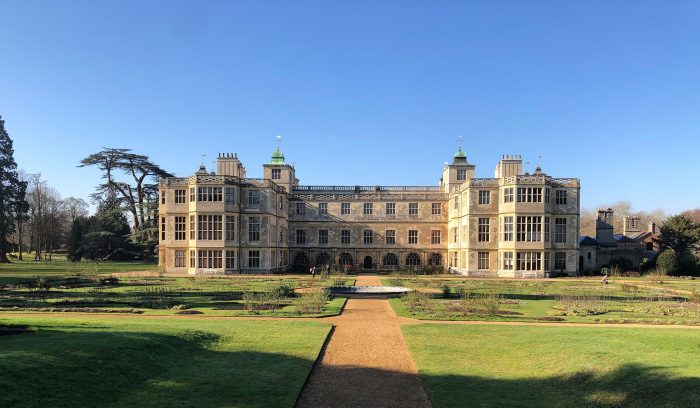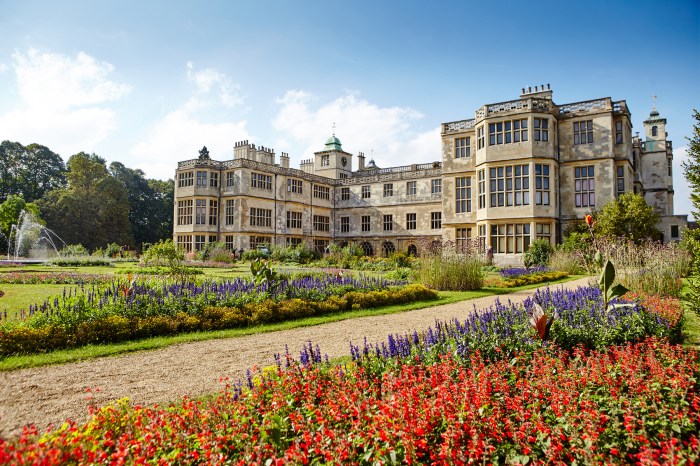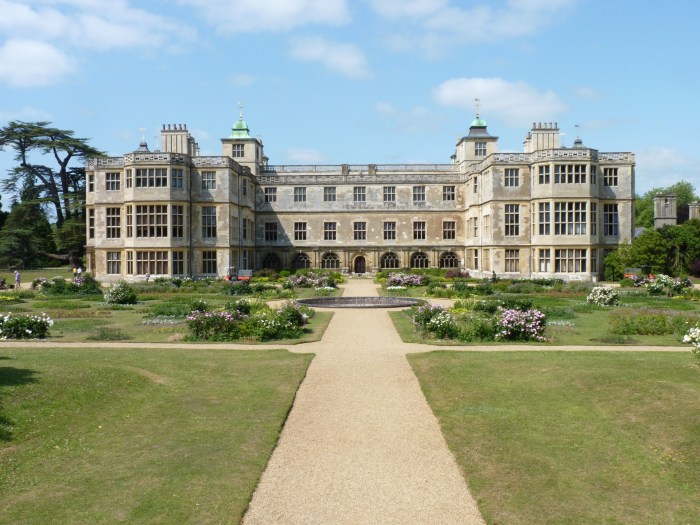Audley End, a magnificent architectural masterpiece and historical treasure, stands as a testament to the grandeur of the past and the enduring legacy of British heritage. Its rich tapestry of architectural styles, opulent interiors, and picturesque gardens invites us on an enthralling journey through time.
From its humble origins to its transformation into a royal palace, Audley End has witnessed pivotal moments in British history, playing host to monarchs, statesmen, and renowned artists. Its grand facade, adorned with intricate carvings and imposing towers, sets the stage for an exploration of architectural ingenuity.
History of Audley End
Audley End is a grand Jacobean mansion in Saffron Walden, Essex, England. It was built between 1605 and 1614 for Thomas Howard, 1st Earl of Suffolk, on the site of an earlier Benedictine monastery.
The house has a long and eventful history. It has been home to some of England’s most famous families, including the Howards, the Montagues, and the Capels. It has also been the setting for many important events, including the signing of the Treaty of Audley End in 1604 and the visit of King James I in 1614.
Origins
The origins of Audley End can be traced back to the 12th century, when a Benedictine monastery was founded on the site. The monastery was dissolved in 1538 by Henry VIII, and the land was granted to Thomas Howard, 1st Earl of Suffolk.
Howard began building Audley End in 1605. The house was designed by Robert Adam and was completed in 1614. It is a magnificent example of Jacobean architecture, and it is one of the largest houses in England.
The Howards
The Howards were one of the most powerful families in England during the Tudor and Stuart periods. They were closely allied with the royal family, and they held many important positions in government.
Audley End, a historic mansion in Essex, is a popular tourist destination. While it may not be known for its scuba diving opportunities, it is still a great place to explore. For those interested in diving, there are many scuba diving locations nearby, offering a chance to explore the underwater world.
After a day of diving, visitors can return to Audley End and relax in its beautiful surroundings.
Thomas Howard, 1st Earl of Suffolk, was the founder of Audley End. He was a close advisor to Queen Elizabeth I, and he served as Lord Chancellor of England from 1601 to 1603.
Thomas Howard’s son, Theophilus Howard, 2nd Earl of Suffolk, inherited Audley End in 1626. He was a prominent figure in the court of King James I, and he served as Lord Chamberlain of England from 1625 to 1642.
The Montagues
The Montagues were another powerful family who owned Audley End. They inherited the house in 1660, and they held it for over a century.
Ralph Montagu, 1st Duke of Montagu, was the first of the Montagues to own Audley End. He was a prominent Whig politician, and he served as Lord Privy Seal from 1699 to 1702.
Ralph Montagu’s son, John Montagu, 2nd Duke of Montagu, inherited Audley End in 1709. He was a noted patron of the arts, and he commissioned many of the paintings and sculptures that can be seen at Audley End today.
The Capels
The Capels were the last family to own Audley End. They inherited the house in 1740, and they held it until 1940.
Arthur Capel, 1st Earl of Essex, was the first of the Capels to own Audley End. He was a prominent Whig politician, and he served as Lord Lieutenant of Ireland from 1760 to 1766.
Audley End, a magnificent Jacobean mansion, stands as a testament to England’s rich architectural heritage. Its grandeur and historical significance have earned it recognition as a UNESCO World Heritage Site. UNESCO World Heritage Sites are places of outstanding universal value that deserve protection and preservation for future generations.
Audley End’s inclusion among these sites highlights its importance as a cultural treasure that embodies the history and artistic achievements of England.
Arthur Capel’s son, George Capel-Coningsby, 5th Earl of Essex, inherited Audley End in 1799. He was a noted collector of art, and he added many important works to the Audley End collection.
The National Trust
In 1940, the Capels sold Audley End to the National Trust. The National Trust is a charity that works to preserve and protect historic buildings and landscapes.
Audley End is now one of the most popular tourist attractions in Essex. It is open to the public every day of the year, and it offers a variety of tours and activities.
Architectural Features

Audley End’s architectural style is a blend of Tudor and Jacobean, reflecting the different periods in which it was built. The original Tudor mansion, constructed in the 16th century, was a relatively modest building. However, when Thomas Howard, 1st Earl of Suffolk, acquired the property in the early 17th century, he embarked on an ambitious expansion and remodeling project that transformed Audley End into one of the grandest houses in England.
Howard employed the renowned architect Robert Adam to design the new facade of the house, which was completed in 1616. Adam’s design is characterized by its symmetry and classical detailing, with a central pediment supported by Ionic columns. The facade is also adorned with a series of elaborate carvings, including the royal arms of King James I and the Howard family crest.
State Rooms
The state rooms at Audley End are among the most impressive in the country. The Great Hall, which is over 100 feet long, is used for banquets and other large gatherings. The Long Gallery, which is over 150 feet long, is lined with portraits of the Howard family and their ancestors.
Gardens
The gardens at Audley End are equally impressive. The formal gardens, which were laid out in the 17th century, feature a series of terraces, fountains, and statues. The informal gardens, which were created in the 18th century, feature a variety of trees, shrubs, and flowers.
Interiors and Furnishings

Audley End’s interiors are a testament to the wealth and opulence of its owners. The house is filled with fine furniture, paintings, and other decorative arts from a variety of periods.
The State Rooms, located on the ground floor, are the most impressive rooms in the house. They were designed to receive guests and to display the owner’s wealth and power. The Great Hall is the largest room in the house and is decorated with a series of tapestries depicting the history of England.
Furniture
The furniture in Audley End is a mix of styles, from Renaissance to Victorian. The most notable pieces include a set of chairs made by Thomas Chippendale and a bed that belonged to Queen Elizabeth I.
Paintings
The collection of paintings at Audley End is one of the most important in the country. It includes works by Titian, Rubens, and Van Dyck. The most famous painting in the collection is a portrait of Queen Elizabeth I by Marcus Gheeraerts the Younger.
Other Decorative Arts
In addition to furniture and paintings, Audley End is also home to a collection of other decorative arts, including tapestries, sculptures, and ceramics. The most notable piece is a set of tapestries woven in the 16th century that depict scenes from the Trojan War.
Gardens and Landscape

Audley End’s gardens and landscape form an integral part of the estate’s grandeur, spanning over 100 acres of meticulously manicured lawns, formal gardens, and picturesque parkland.
Audley End, a magnificent Jacobean mansion, boasts a rich history and stunning architecture. Its sprawling grounds offer visitors a glimpse into the grandeur of the past. While Audley End is certainly a destination in its own right, it’s also an excellent starting point for exploring the surrounding area.
For those seeking a unique adventure, a drive to the 7 mile bridge is highly recommended. This iconic bridge, stretching across the Florida Keys, offers breathtaking views and a thrilling driving experience. After soaking in the beauty of the bridge, return to Audley End for a leisurely stroll through its gardens or a bite to eat in one of its charming cafes.
The gardens have evolved over centuries, reflecting the changing tastes and styles of their owners. The earliest records date back to the 16th century, when the estate was owned by the Audley family. They laid out formal gardens in the Tudor style, characterized by geometric patterns, knot gardens, and elaborate topiary.
Formal Gardens
The formal gardens at Audley End are a testament to the grandeur and opulence of the Jacobean era. They were designed by Inigo Jones, one of the most influential architects of the time, and feature a series of terraces, fountains, and statues. The gardens are divided into several distinct areas, each with its own unique character.
- The Privy Garden is the most private and secluded of the formal gardens. It is surrounded by high walls and features a central fountain and a series of intricate parterres.
- The Outer Court is a grand, open space that leads to the main entrance of the house. It is flanked by two long terraces and features a large fountain at its center.
- The Rose Garden is a more recent addition to the formal gardens, having been created in the 19th century. It features a wide variety of roses, as well as other flowering plants.
Parkland
The parkland at Audley End is a vast, rolling landscape that extends for miles in all directions. It was created in the 18th century by Capability Brown, one of the most famous landscape architects of the time. Brown’s design aimed to create a natural and picturesque landscape that would complement the grandeur of the house.
The parkland is home to a wide variety of trees, shrubs, and flowers. It is also home to a herd of fallow deer, which roam freely through the landscape.
Cultural and Social Significance: Audley End
Audley End House holds immense cultural and social significance, deeply entwined with British history, the aristocracy, and the arts.
Its grandeur and architectural brilliance have captivated generations, serving as a backdrop for countless events and gatherings that have shaped the nation’s social and cultural landscape.
Royal Connections
- Built by Thomas Howard, 1st Earl of Suffolk, Audley End became a royal residence in 1607 when King James I acquired it.
- Subsequent monarchs, including Charles I and Charles II, made significant alterations and additions to the house, leaving their mark on its architectural evolution.
Aristocratic Influence
- Audley End was a prominent center for aristocratic life and entertainment, hosting lavish parties and gatherings.
- The house’s owners, including the Earls of Suffolk and the Dukes of York, played significant roles in British politics and society, influencing cultural trends and artistic patronage.
Artistic Inspiration
- The grandeur of Audley End has inspired countless artists, writers, and musicians throughout history.
- Painters such as John Constable and J.M.W. Turner captured the house’s picturesque beauty in their works, while poets like John Keats and Samuel Taylor Coleridge found inspiration in its gardens and landscapes.
Restoration and Preservation

Audley End has undergone extensive restoration and preservation efforts over the centuries to maintain its architectural integrity and historical significance.
In the 19th century, major renovations were undertaken by Sir John Griffin Griffin, who restored the house to its former grandeur and added new wings. In the 20th century, the house was acquired by the National Trust, which has since overseen its ongoing conservation and preservation.
Challenges and Successes
Restoring and preserving Audley End has presented numerous challenges. The sheer size and complexity of the house, with its vast rooms and intricate architectural details, requires specialized expertise and resources. Additionally, the passage of time and exposure to the elements have taken their toll on the building’s materials and finishes.
Despite these challenges, significant progress has been made in preserving Audley End. The National Trust has implemented a comprehensive conservation plan that involves ongoing repairs, maintenance, and restoration projects. These efforts have included the restoration of the house’s exterior, including the repair of stonework and windows, as well as the conservation of its interiors, such as the restoration of painted ceilings and tapestries.
Importance of Preservation, Audley end
Preserving Audley End is of paramount importance for future generations. The house is a unique and irreplaceable piece of architectural and historical heritage that provides a glimpse into the past and the lives of those who have lived within its walls. By maintaining its authenticity and integrity, we ensure that Audley End will continue to inspire and educate future generations.
Conclusive Thoughts

Audley End’s enduring significance extends beyond its physical beauty. It serves as a living testament to the artistic and cultural achievements of its time, inspiring generations of architects, designers, and historians. Its restoration and preservation efforts ensure that this architectural gem will continue to captivate and inspire for centuries to come.
Helpful Answers
What is the architectural style of Audley End?
Audley End primarily exhibits Jacobean architecture, characterized by its elaborate ornamentation, symmetrical facades, and grand proportions.
Who was responsible for the initial construction of Audley End?
Sir Thomas Audley, Lord Chancellor to Henry VIII, commissioned the construction of Audley End in the 16th century.
What is the significance of the gardens at Audley End?
The gardens at Audley End, designed by Capability Brown, are renowned for their picturesque landscapes, serpentine lakes, and formal terraces.